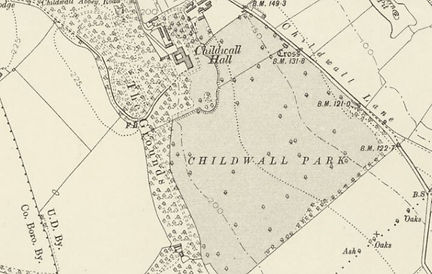
Before I begin to describe the history of Childwall Hall and woods, it would be very useful to provide some context as to the location today and the beauty of Childwall Woods. For those who have lived in the area, past and present, I suspect that nearly everyone has walked through Childwall Woods at one point. But for those who have never ventured in, it is an oasis of calm in the heart of Childwall.
The noise of vehicles from Childwall Park Avenue melt away, and the further you access into the central parts of the wood, you could be back in time over two hundred years ago, when the sounds of nature were the only background noise.
Childwall Woods can be accessed from Childwall Abbey Road, Countisbury Drive, Quickswood Close, and of course from the rear of Childwall Fields. Whichever view point you start from, you are guaranteed a different outlook on the area.
The Childwall Abbey Road (gatehouse) entrance provides you with the ‘original’ grand entrance that horse and carriage would have taken, and you are easily led towards the ‘carriageway’ that once led to Childwall Hall (more about the Hall later). The Countisbury Drive entrance lands you right on top of the ‘bridge’ section overlooking the carriageway, and the remains of what I believe to be the groundsman’s cottage further down. The Quickswood Close ‘gate’ always seems to be the most mysterious part of the woods entrance as you arrive from a small cul-de-sac into a dark part of the woods. I’ve never attempted a walk at night from this area, but it is on my to-do list!
Finally, if one is to take the long walk from Childwall Lane, up through Childwall Fields (nicknamed as the 3 hills for the obvious reason), the woods taken on a more sombre view and remind me of ‘Mole’ walking up to the Wild Woods in the Wind in the Willows. However, we must not forget that the two sections (Childwall Woods & Childwall Fields) are separate areas. As you can see from the map on the left, the woods were once named ‘The Grounds’ (i.e. the grounds to Childwall Hall) and ‘Childwall Park’ being what is now the ‘three hills’ area. Childwall Park also extended into what is now Lime Pictures as part of the original golf course for Childwall Hall.
Ownership of the estate in Childwall can be traced as far back as the 13th century when William de Ferrers, 4th Earl of Derby became its heir upon his marriage to Agnes of Chester, daughter of Hugh of Cyfeiliog, 5th Earl of Chester. By 1303 the land had been obtained by Robert Holland, 1st Baron Holand and by 1361 was recorded as being the property of Henry of Grosmont, 1st Duke of Lancaster.
The estate continued to pass between noblemen: from Robert de Lanthom to John Stanley (KG) before being obtained by the Le Grey family who sold it to lawyer Isaac Greene of Liverpool. Upon Greene's death in 1749 his daughter Mary inherited the estate and married Bamber Gascoyne (the elder). By 1780 their son Bamber Gascoyne (the younger) was elected MP for Liverpool and eventually inherited the family estate, which he decided to have Childwall Hall rebuilt. For the rebuild, Bamber Gascoyne (the younger) employed architect John Nash, who at the time was architect to the Surveyor General of Woods, Forests, Parks, and Chases and rarely took private commissions.
CHILDWALL_HALL_JPG.jpg)
Before we delve into the history of Childwall Hall, it would be most interesting to understand the layout of the entire property and access points. As per the above map (top left), Childwall Hall stood at the edge of what is now Childwall Woods and Childwall park, although in reality, this was all once private land to Childwall Hall. The actual Hall stood roughly where the building of Lime Pictures stands today. If you were to stand in the car park at Lime Pictures, to the left of the main entrance is roughly where the front door of Childwall Hall once stood.

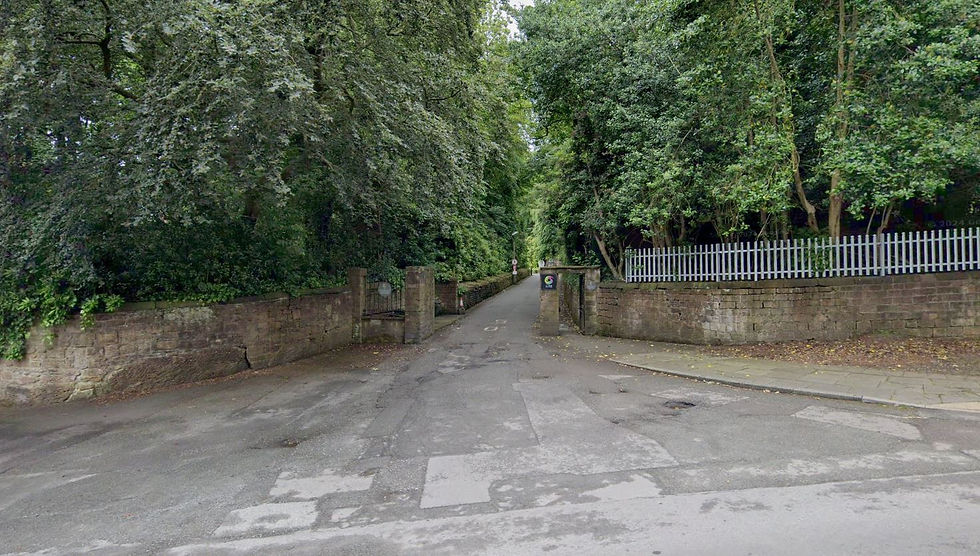

Childwall Hall was accessed by multiple points depending if you were travelling on foot, by horse and carriage or later on by car. Firstly, one could travel by foot, or by carriage, via the main entrance of the grounds situated at the rear of the Gatehouse on Childwall Abbey Road. If you travelled by carriage, you would take the ‘carriageway’ route (nicknamed ‘the moat’) via the curved pathway on the right-hand side. This would lead to the front door of Childwall Hall. Similar if you walked on foot, you would use the main paths in Childwall Woods and arrive at the front door. If you entered via what is now the access point by the roundabout at the end of Childwall Park Avenue, you would again walk through the woods, but your journey would be halted by the gatehouse. (more on the gatehouses later). With the invention of the car, Childwall Hall could also be accessed by the side entrance on Childwall Abbey Road. A far more hospitable route considering the road (at least from older images) appeared to be paved and wouldn’t have been as problematic as getting stuck in the carriageway when it was raining due to the curve and the incline. On Childwall Lane, there was also a side entrance (now bricked up) for access to the lower grounds of Childwall Hall where they grew produce. It would have saved the climb up Childwall Abbey Road that’s for sure! We see the different entrances above right.
John Nash designed his own property called East Cowes Castle. Completed in 1800, it was said to have been built 'at unlimited expense'. Therefore with a few changes to the design, John Nash would have been happy to work on something that reflected his own house, and probably used lots of previous drawings and plans to quicken the build rather than to build and design from scratch. We see East Cowes Castle here to the right.
However, John Nash also (amongst others) designed an additional property called Lough Cutra Castle. In a strange twist of fate, a replica of East Cowes Castle was built in Ireland called Lough Cutra Castle. I was therefore astounded to see that this building still survives and is a near replica of Childwall Hall! I wrote off to the owners and was asked if they would supply me with some images of Lough Cutra Castle so I could at least see a view or two. The owners were delighted and also sent me some original interior images. The below images are literally like looking at Childwall Hall's interior and exterior!


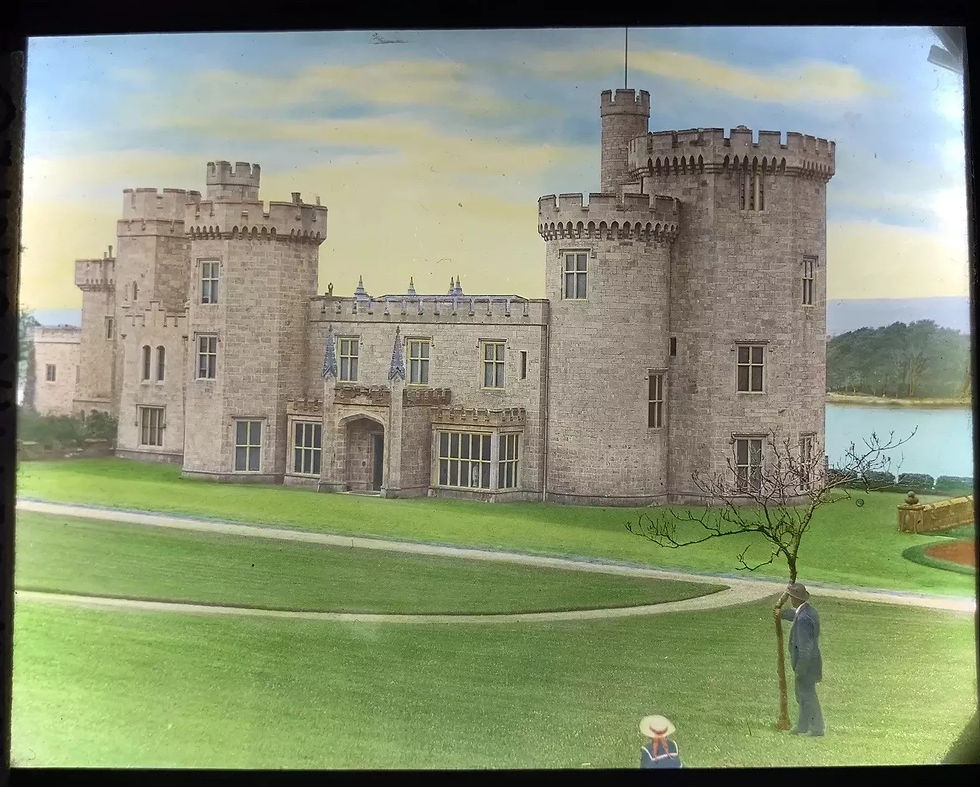

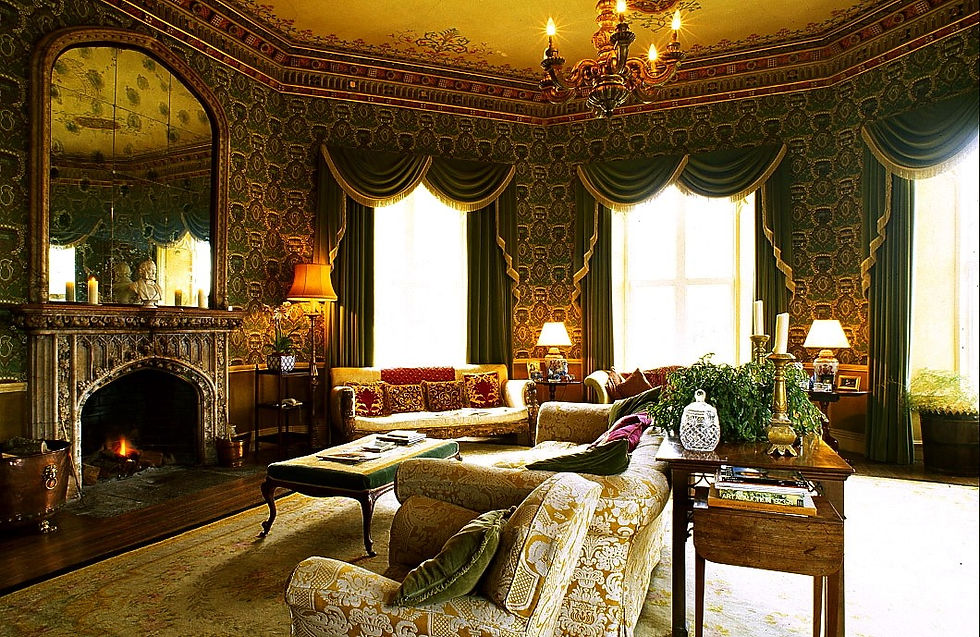

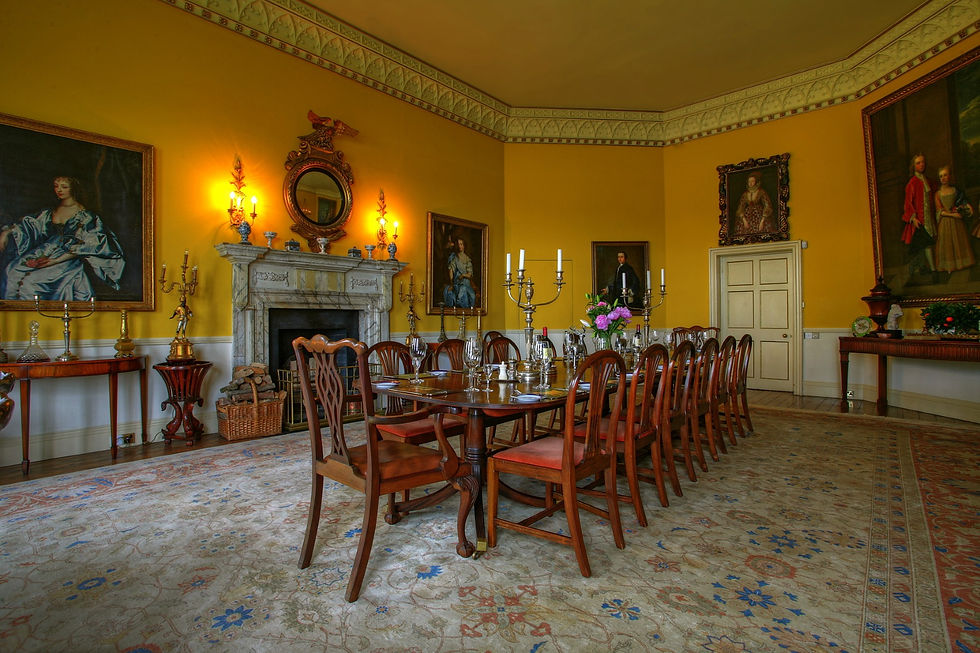

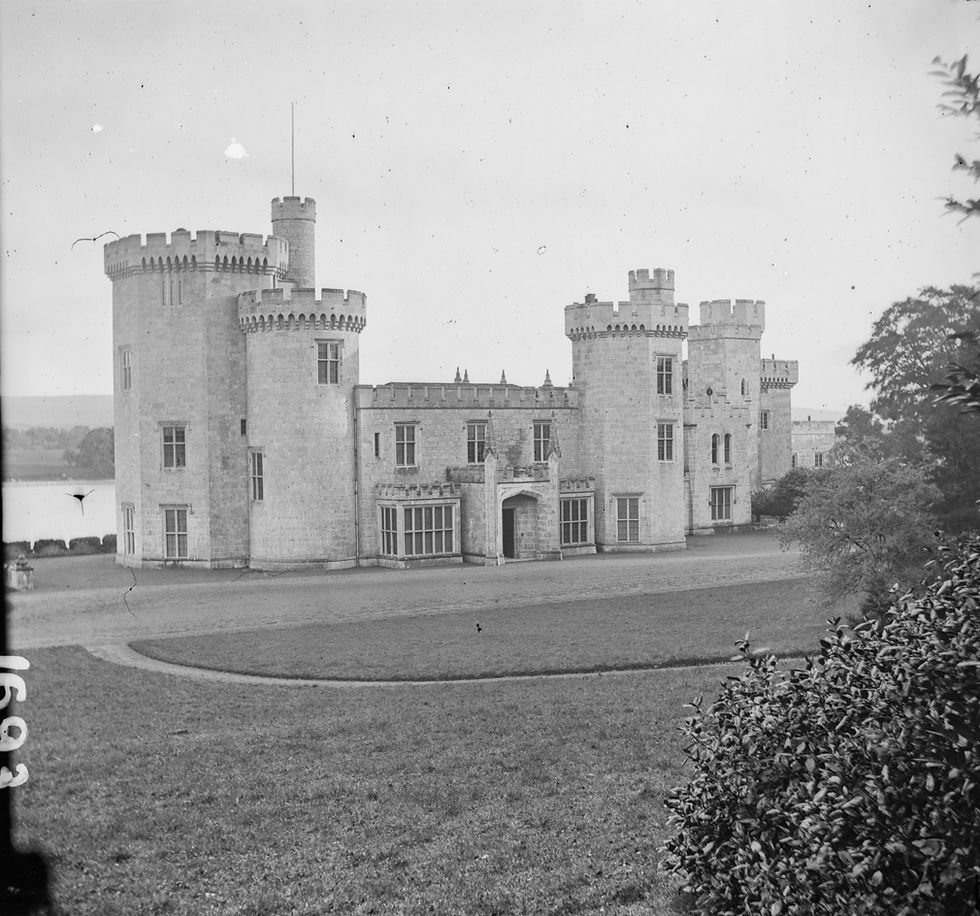
The new interior of Childwall Hall included a drawing room, a dining room, a study and a well-furnished library at the request of Gascoyne, who was a keen reader. On the death of Bamber the younger in 1824, the hall and surrounding estate passed to his only child Francis Mary Gascoyne, who a few years previously had married James Gascoyne-Cecil, 2nd Marquess of Salisbury and moved away from the area. Subsequently the estate was put out to rent and became the residence of various wealthy families. Below, we see a selection of Childwall Hall images.
















Between about 1901 and 1919 Childwall Hall was leased by the wealthy Schintz family. Hans Gaspard Schintz was born in Zurich in 1837 but settled in Liverpool some time before 1861 and was granted British Nationality in 1875. His wealth came from saltpetre nitrates sourced in Tarapaca province, northern Chile, by his company the Tamarugal Nitrates Co. On the right is Hans Gaspard Schintz and his wife Anna Julia (nee Bleuler). Please note this image is copyright to Annabel Collenette.
Hans Gaspard Schintz married Anna Julia Bleuler with whom he had three children, all born in Liverpool. The eldest child, Hans Caspar Ferdinand Max, was born in 1865 but died without issue in Switzerland in 1911. The second child, Julia Lucy Schintz was born the following year and married John Smith Moreton in 1897. The youngest child was Susan Dora Cecilia Schintz who was born in 1869 and remained a spinster. The Schintz family lived at several addresses in Liverpool and had moved to Childwall Hall by 1901.
Childwall Hall wasn't just for the Schintz family to rattle around in, they had up to 16 indoor servants! In the middle of 1900, it was Dora (see image to the right) who seemed to have taken over the running of the household. One of her advertisements was:
Wanted, Useful MAID; thoroughly experienced dressmaker, neat sewer, good cut and careful fitting essential; not under 5' 4"; no fringe; quiet place, no travelling, 10 servants; dogs; excellent and long references required; wages "28, all found - Miss Schintz, Childwall Hall.
Also noted was that the Schintz family owned several dogs. Among them was a Great Dane named Tyras which was buried in Childwall Wood. Its headstone which was engraved 'In memory of Tyras the Great Dane, born July 1895, died December 1904', survived until recently but may now be lost under bushes.





At the outbreak of WWI Miss Schintz, took Arrowe Hall in Birkenhead and set it up as an Auxiliary Military Hospital. She paid for the fitting out of the hospital for the staff, and provided a fleet of vehicles to transport patients. One patient was Frederick Rapson who had been a driver for the Kings messenger Service on the Western Front and South Africa, and before the war had driven for the royal household.
When he was sufficiently recovered from his injuries Miss Schintz took him on as her chauffeur and from late 1916 he lived and worked at The Garage, Childwall Hall. By 1918 he had a team of men working under him on the Schintzs fleet of cars. Rapson was not only an experienced driver and mechanic but also a prolific inventor, principally of devices for motor cars. Rapson was now associated with considerable wealth and meeting Miss Schintz was to give him the financial support he needed for a new business life. Frederick Rapson with the Schintz 1914 Silver Ghost outside the stableyard at Childwall Hall. Rapson is demonstrating his engine powered Rapid jacks. (The Autocar 28th July 1917).





The stable block at Childwall Hall was also extensive. The buildings and garages would have provided Dora with the opportunity to expand on her interest in Hackney horses which became a large part of her life before the first world war. Dora also took a liking to photography and there are excellent views of the hall that Dora took. I have been allowed to reproduce them here from the personal family archive from Annabel Collenette.
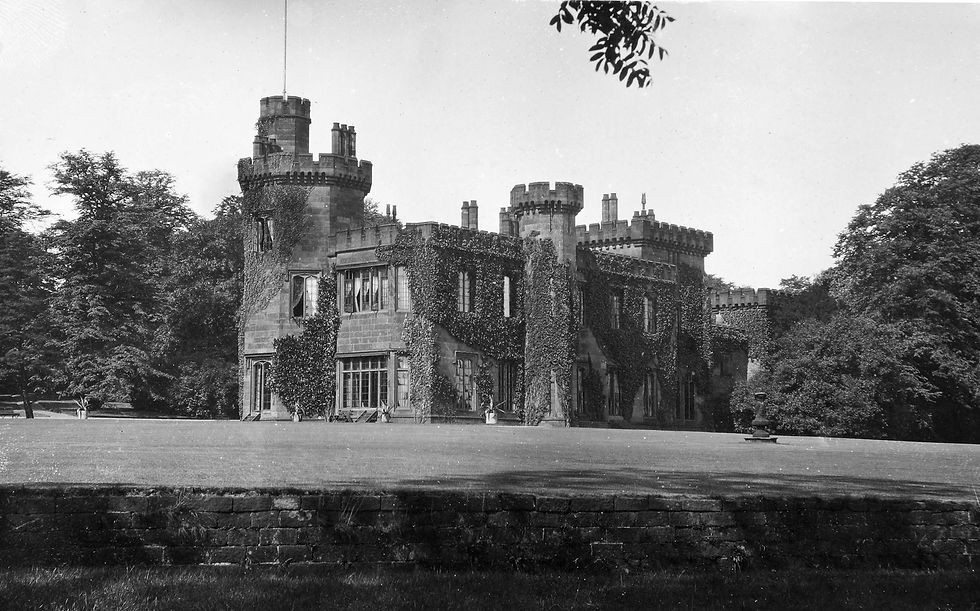
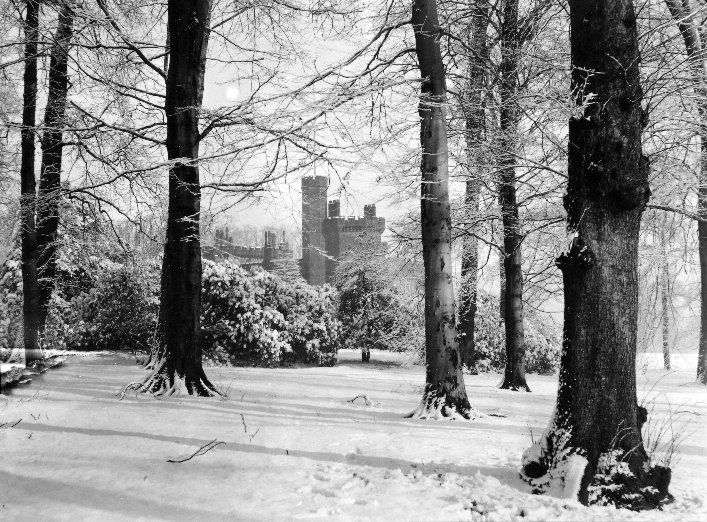

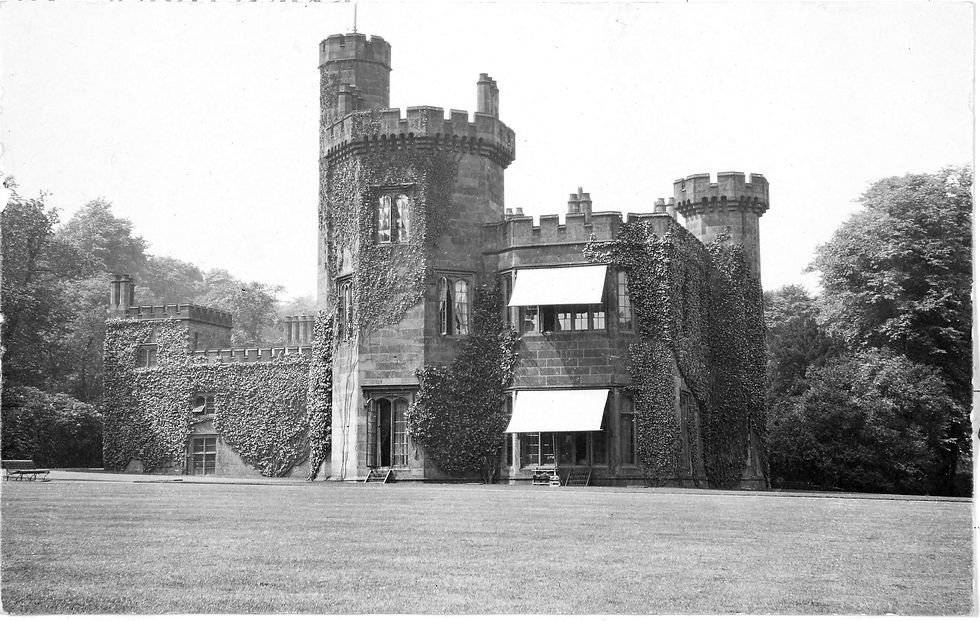
In late 1912 Hans Gaspard died. Although he did not leave anything to charity in his will, his widow donated to various charities in Liverpool from his estate. Susan Schintz inherited a share of her fathers fortune the income from which enabled her to spend generously on charitable works. Miss Schintz, like her mother, supported numerous charities including a Home for Incurables and the Schintz Nursing Home in Liverpool.
In 1919 Miss Schintz moved away from Childwall Hall and purchased Ottershaw Park in Surrey. She maintained that this was to benefit her mother who would appreciate the countryside but it also benefited Rapson, who was by now working on an un-puncturable tyre design and Ottershaw was ideally located for easy access to Brooklands motor circuit where he carried out many trials. Over the next decade Miss Schintz invested heavily in Rapsons tyres and other inventions, to the extent that she eventually became bankrupt in 1930. Dora passed away in the Kent and Canterbury Hospital on 12th June 1954 aged 84, and so ended the life of an extraordinary lady.
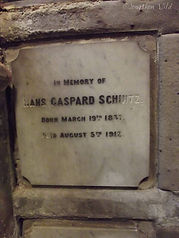
In 1922, Childwall Hall was vacated to private residents and became Childwall Golf Club HQ. The Gold Club had to move from Woolton because the owners wanted to sell the land. Childwall Golf Club used the building and provided an 18 hole Golf course that sat on Childwall Fields and also included what is now the small cul-de-sac Cabot Green. The Golf course stood there till 1938 and Childwall Hall was sold on to the Corporation including the land for £10,000. War broke out from 1939 to 1945 and the Corporation had bigger issues to deal with. Childwall Hall was more or left 'abandoned' until it was discovered that there was extensive dry rot in the building. The Corporation had desires to turn this building in to a college but this was abandoned and sadly the building was demolished in 1949 leaving only the stable block remaining to this day.
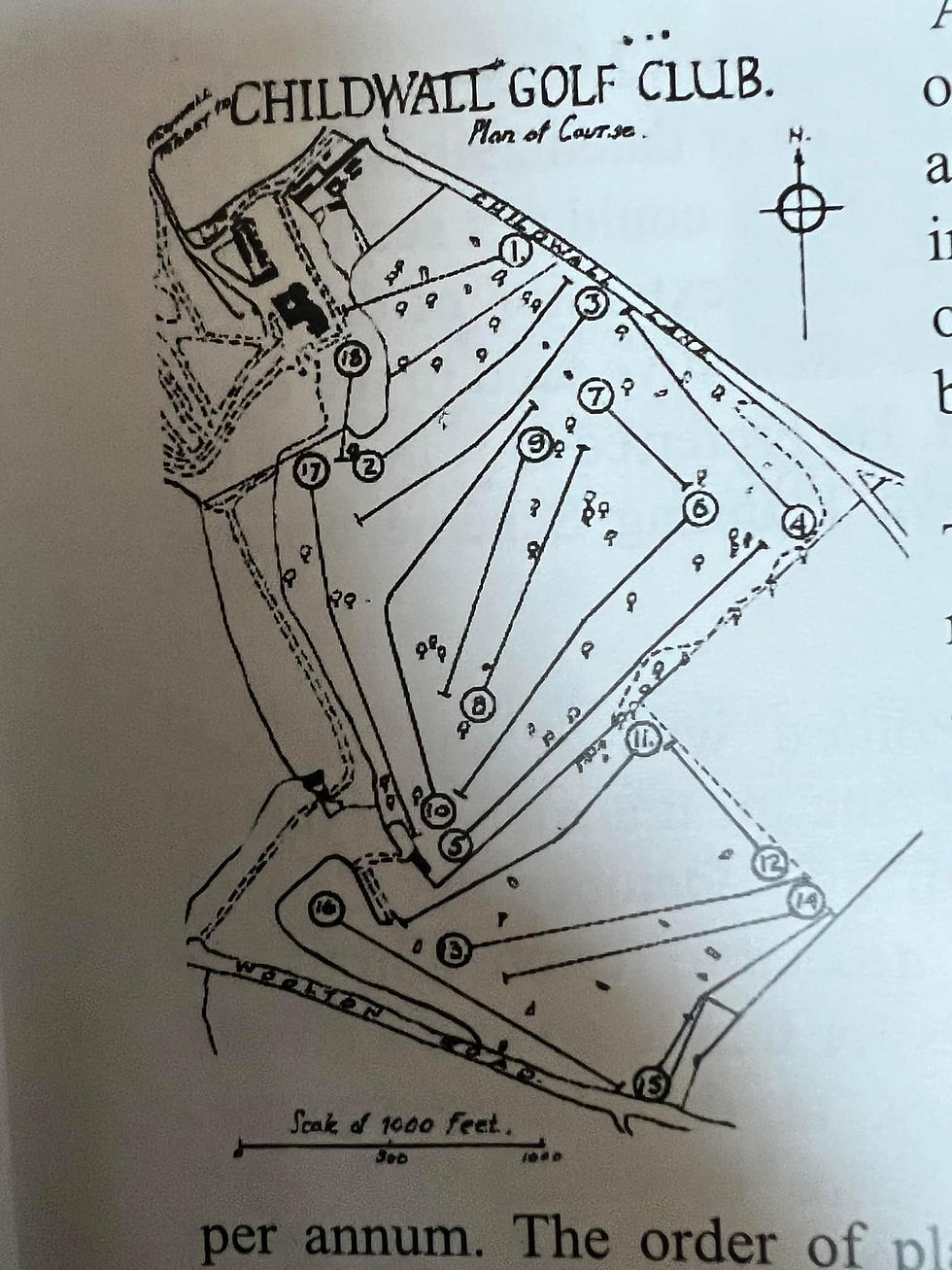




Within Childwall Woods, there were two gatehouses. One at the top of Childwall Abbey Road, and one 'inside' the grounds roughly at the rear of what is now Cabot Green. There are no specific dates for these buildings, however considering the Childwall Abbey Road gatehouse appears in the same style of John Nash, I think this was constructed at the same time. Contemporary images of the other gatehouse show a slightly older design and this may well have stood there before the construction of the 'second' Childwall Hall. It is also interesting to see the changes to the now demolished 'keepers lodge'.

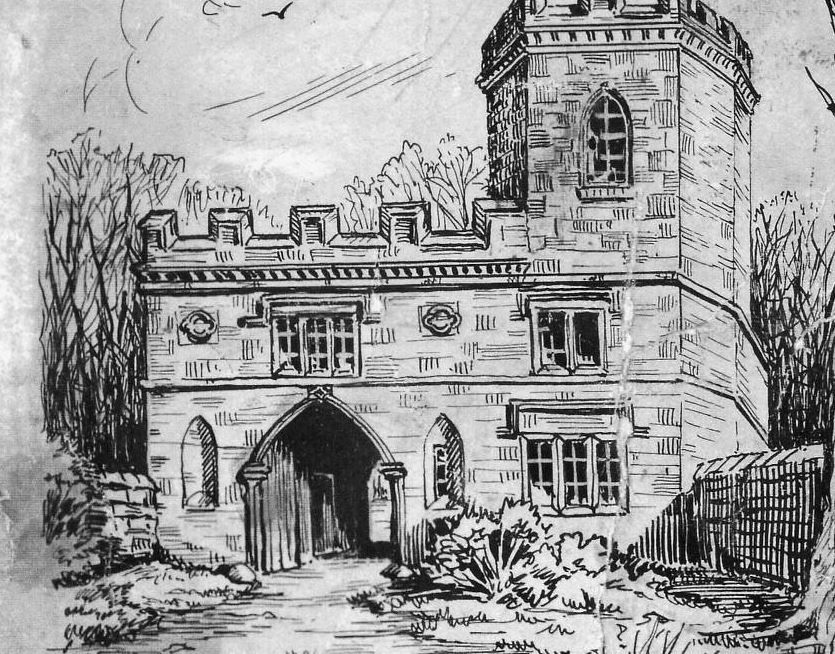
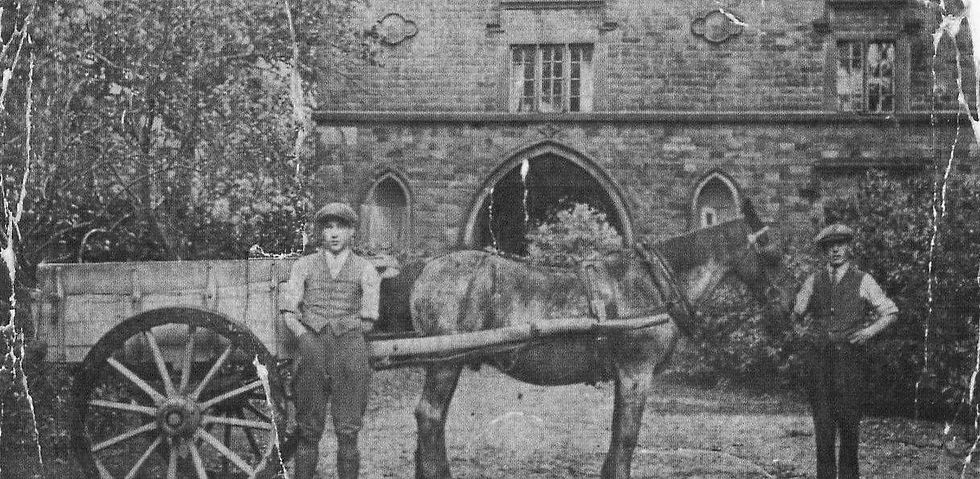


If one is to walk from the Countisbury Drive entrance and bypass the bridge over the carriageway, you will come to a sandstone wall. This appears to be some sort of building that has now been filled in (and is an excellent slide in the winter!). There was talk of this being the horses graveyard where they were buried from Childwall Hall, but my good friend John Athersuch (see below) has found absolutely no evidence to suggest this ever happened.
We believe that this was either a 3rd gatehouse or a groundsman's cottage. I recently came across the below drawing titled 'Childwall Woods' and believe this to be the former cottage that stood next to the carriageway. In the days of Childwall Hall, there would have been no bridge across the 'moat'. I (Jonathon Wild) was contacted by a member of Lime Pictures to ask if I would like to view the area as this was once the 'footprint' of Childwall Hall. I didn't need asking twice and after grabbing the camera, headed up to discover the history. The pictures were strictly limited to the original walls and surrounding area of Childwall Hall and we are very grateful to Lime Pictures for the kind opportunity! We have produced the pictures below with kind permission from Lime Pictures.


The stable block and side entrance! The shortened wall can be seen on the right hand side picture - exactly the same place as the pre 1920 photograph!


The views here show the gateway to the side entrance to the stable block. The picture on the right shows the outer walls of the stable block - the window itself can be found on pictures of Childwall Hall.


The views here (left) show what was part of the original roadway from the era of Childwall House and is still used to this day. There is a set of sandstone blocks which form the entrance to the other side of the stable yard.


This area is the entrance to the former stable yard, now used as a surplus car park. There is a great deal of original sandstone brickwork here with some very nice archways leading out of both sides of the stable yard.
At one point, this would have been a covered area but now all that remains are the surrounding walls.



With access from Childwall Woods, the rear of the wall throws up many more puzzles as to why it is there and what it was originally used for. There are steps leading down to the right hand side of the wall, but further back there are also concrete steps that lead nowhere! It would appear that this may have been a seperate 'porch' for Childwall Hall or perhaps an out building for storage. Certainly the arched doorways are too good for a 'standard' out building but the real puzzle is the steps that lead to a 4ft drop!
John Athersuch was recently in contact with me to provide updated information on Childwall Hall and to provide some amazing pictures, never seen before! John met with the grand niece of Miss Schintz and her daughter in law. They had a wonderful collection of family phots including some of Ottershaw Park and Childwall Hall. They are not dated but but must be pre 1920 as Miss Schintz was at Ottershaw by then. Our thanks go once again to John and to both Sheila and Annabel Collenette for permission to use the photographs.
The second book is titled: The Trials and Tribulations of Dora Schintz
This book tells the story of Dora Schintz a little-known female philanthropist who inherited a vast fortune and was at one time owner of one of the finest houses in the country. She rose to prominence in the world of hackney horses, gave generously to charity and financed hospitals for incurables and the wounded of The First World War. Her generosity led her to fund an inspired engineer and inventor, which eventually contributed greatly to her financial ruin. Her final years were spent in poor health living in boarding houses until she died alone and in penury. Dora Schintz and the Schintz family once owned Childwall Hall!
It is a fantastic read and can be found via amazon by clicking on the image:
John Athersuch, the author of these books can also be contacted directly via e-mail at johnathersuch@gmail.com
My good friend John Athersuch has authored books on local history. Two of his books are of great interest to Childwall.
The first book is titled: An Illustrated History of Ottershaw Park Estate 1761 - 2011
This book is the first to provide a comprehensive and fully illustrated historical survey of this little-known estate, giving detailed accounts of its buildings and occupants, and providing biographies of its owners and principal leaseholders. The connection to Childwall is that Dora Schintz, once owner of Childwall hall once owned Ottershaw Park.
It is a fantastic read and can be found via amazon by clicking on the image:

